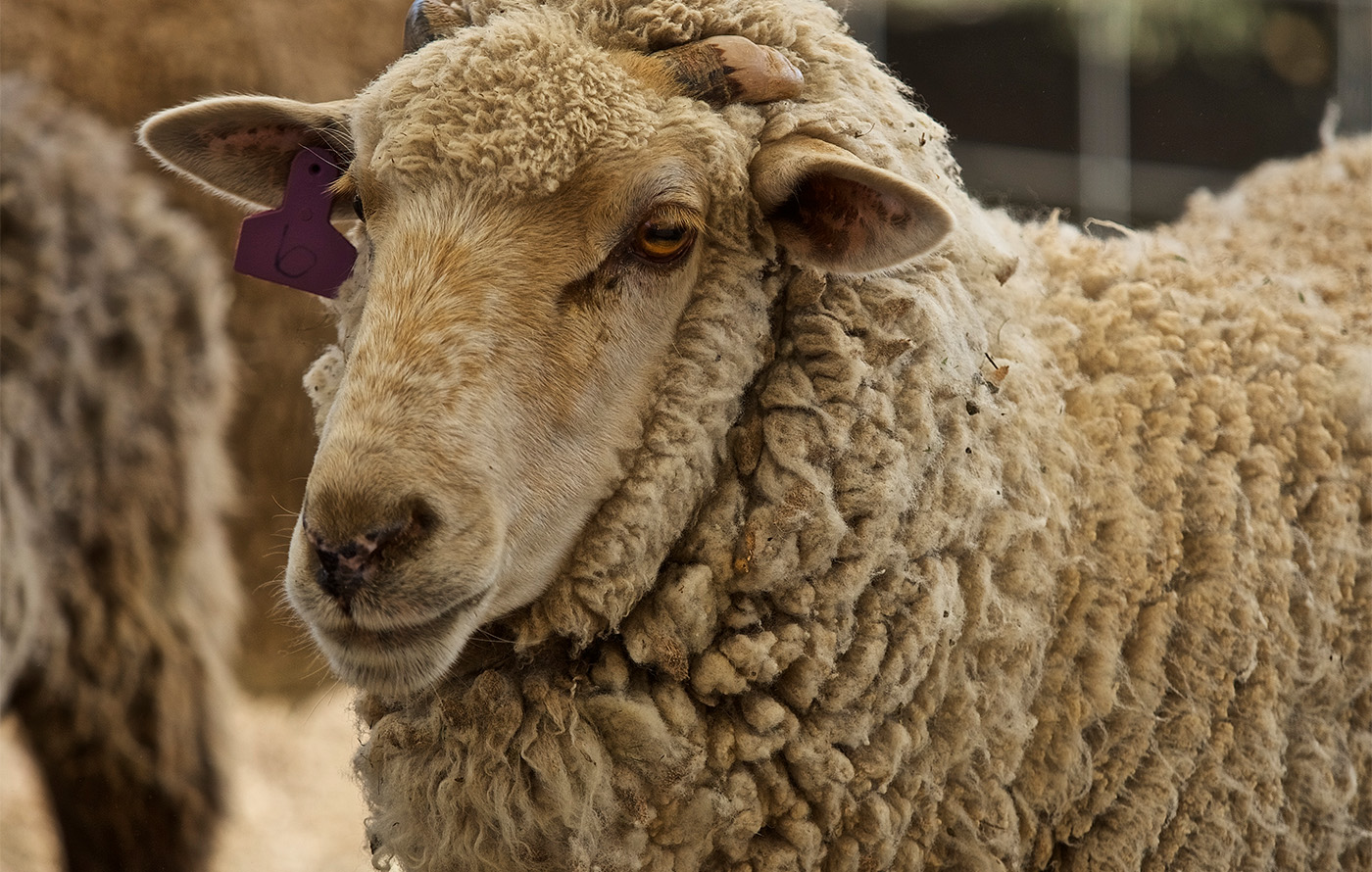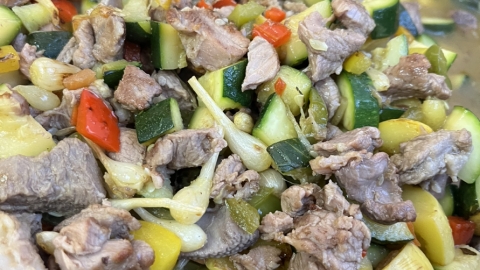Navajo Lifeway: Diné Bé’Iiná
Diné philosophy, spirituality, and sheep are intertwined like wool in the strongest weaving. Sheep symbolize the Good Life, living in harmony and balance on the land. Before the Diné acquired domesticated sheep on this continent, they held the idea of sheep in their collective memory for thousands of years, thus carrying carved sheep fetishes in their pollen bags. While wild mountain sheep provided meat and the Diné gathered wool from the shedding places, the species of sheep in North America do not have a herd behavior that permits domestication. As a result, the Diné asked their Holy People to send them a sheep that would live with them and with care, they would provide a sustainable living, and it was then the sheep Taa’ Dibe’ became into being. Sheep is in every essence an important part of our culture and traditions.
Roy Kady —Navajo-Churro shepherd and traditional Navajo weaver
_______
A towering red cliff mesa behind me, a traditional Navajo hogan in front of me—I have arrived at Sheep is Life at the Navajo Nation Museum in Window Rock, Arizona. Sheep is Life is the annual celebration of the Navajo-Churro sheep, a breed which holds deep significance for the Diné people. I was honored to be attending with other representatives of Slow Food USA. Sheep is Life brings together all those who love sheep, wool fiber, arts, food and the cultures that have maintained Navajo lifeways for thousands of years.
History
In the mid-16th century, early Spanish colonizers brought Iberian sheep to Mexico City and then to the Rio Grande Valley in New Mexico. For the next 200 years the breed thrived on Spanish settlements across the southwest. They adapted to the arid climate and rough landscape. They were traded and passed to Navajo and Pueblo tribes. This is the domesticated sheep that was foretold in Navajo legends. Navajo-Churro flocks became a cultural focus for the Diné way of life, providing fiber, meat, and milk.
Then, as the United States expanded west, white settlers and Indigenous people clashed over the land and the United States declared war on the Navajo/Diné people. The US Army fought to remove the Diné from their homeland. Colonel Kit Carson carried out a scorched-earth policy, destroying homes, gardens, orchards and livestock, including a slaughter of Churro sheep. In 1864 thousands of Navajos were forced to walk to a concentration camp at Bosque Redondo (Fort Sumner). This tragic period was called “The Long Walk.” Many died. A few fled to hide in remote canyons, taking their precious Churro sheep with them.
After four cruel years of disease and starvation Navajo leaders successfully negotiated a treaty with the Indian Peace Commission. The Navajo people were released to return home to their traditional lifeways.
As part of the treaty each family was given a pair of sheep. The sheep and people resumed their mutually supportive roles. The Navajo built income on weavings and raw wool. The sheep sustained the people. Flocks increased abundantly.
In the 1930’s government agencies stepped in to reduce flock size to avoid overgrazing. The government slaughtered or forced the sale of over half the herds. In the 1950’s government agencies again interfered to “improve” the breed. Exotic breeds were introduced and bred to produce a bigger animal with more meat. These “improvements” were carried out without the people’s consent. No consideration was given to the strengths of the Navajo-Churro, much less their cultural value. By 1972 few Churro remained; the Navajo-Churro was on the endangered species list.
Restoration of this valuable breed began with Dr. Lyle G. “Doc” McNeal of Utah State University. He saw the Churro sheep going the way of the buffalo and stepped up to save the breed from extinction. McNeal searched out remnants of the original strain—less than four hundred—and founded the Navajo Sheep Project (NSP) to bring back the breed. There are now over 5,000 Navajo-Churro sheep registered with NSP. Sheep is Life is the NSP annual celebration held every year in mid June.
What is the Navajo-Churro?
The Navajo-Churro is the oldest breed of sheep found in America. For four centuries it thrived in the harsh, dry, and extremely hot or cold conditions of the American Southwest. They are hardy and strong, fecund, resistant to disease, docile and very personable. They are built for tough conditions, and display excellent mothering and survival instincts.
If you ask a weaver, he or she will tell you Navajo-Churro are prized for their wool. It’s an unusual and remarkable fiber. Due to its low lanolin content, it is easy to wash, comb and spin. The wool has an exceptionally long fiber length (long staple) and is durable and strong. 100-year-old rugs just get better with age. For clothing it’s elastic, moisture-wicking and insulating. The sheep themselves come in a variety of natural colors and the wool easily absorbs dyes giving vibrant, long-lasting hues. You can see the wide palate of color in historic and contemporary weaving.
Since the Holy People brought the Churros, Indigenous cultures have woven with craftsmanship and artistry, creating rugs, blankets and clothing that are both practical and hold deep cultural symbolism, preserving the traditions and stories of the people. As for the meat: “Navajo-Churro lambs produced in Navajo country are range-fed, antibiotic-free, and parasite-free. Because the fat of this breed is typically concentrated around the organs rather than being spread throughout the body, even the meat from animals reaching fourteen to sixteen months of age does not suffer from the musky, “muttony” smell that afflicts other breeds. Instead, it retains a light, herbal fragrance and a complex, grassy flavor reflecting the unique terroir. The meat is highly valued by Navajo people, traditional cooks, food connoisseurs and celebrity chefs.” — Slow Food Navajo Sheep Presidium.
Navajo-Churro Sheep also produce milk with a higher cream content than cow or goat milk, which makes it superior for dairy products and cheese making.
Sheep is Life
And this brings me to the Sheep is Life festival held every June. It’s a celebration, a “Blessing way ceremony for our continuance here on earth, and for the next generations to come,” according to Roy Kady, Sheep is Life Celebration Coordinator.
It was exciting to be at the 27th Annual Sheep is Life Celebration; to learn and experience the festival. Beginning with a sunrise blessing at the hogan, the museum grounds fill with attendees and presenters: traditional and non-traditional weavers, spinners, dyers, artists, jewelers, woodworkers and adobe brick makers. The schedule fills the days with presentations on regenerative agriculture, food as medicine, the history of weaving, videos and stories from elders, and awards for outstanding support of Churro lifeways. Some talks focus on sheep –veterinary care, ram fertility, vaccinations and breed standards. The sheep corral is full of action and lots of bleating, featuring breed and wool judging, shearing demonstrations and workshops, and a sheep show. There are talks and demonstrations on weaving—wool processing, sash belt weaving, traditional basketry, a sheep-to-loom spin-off, wool judging and a silent auction (where I picked up a couple of pounds of washed and combed Churro wool with a traditional Navajo spindle).
Under one tent a sheep is traditionally and respectfully harvested for cooking and tasting. Chef Mackee Bancroft works with community health advocates of elders and youth to serve up a tasting menu curated by Denisa Livingston (Diné Community Advocacy Alliance) to showcase Indigenous foods: Wheatberry & Prickly Pear Cactus Parfait, Amaranth & Chokecherry Salad, Navajo Churro Lamb, Manoomin (wild rice) & Squash, Three Sisters Stew, Native Tea and Infused Fruit Water.
If you want to learn more about Navajo lifeways and the Churro sheep, I recommend you watch A Gift from Talking God (The Navajo Sacred Sheep), a beautifully filmed video available on YouTube. Visit Sheep is Life 2024 in mid-June. In addition, definitely try this recipe for Three Sisters Stew for a taste of Sheep is Life.






